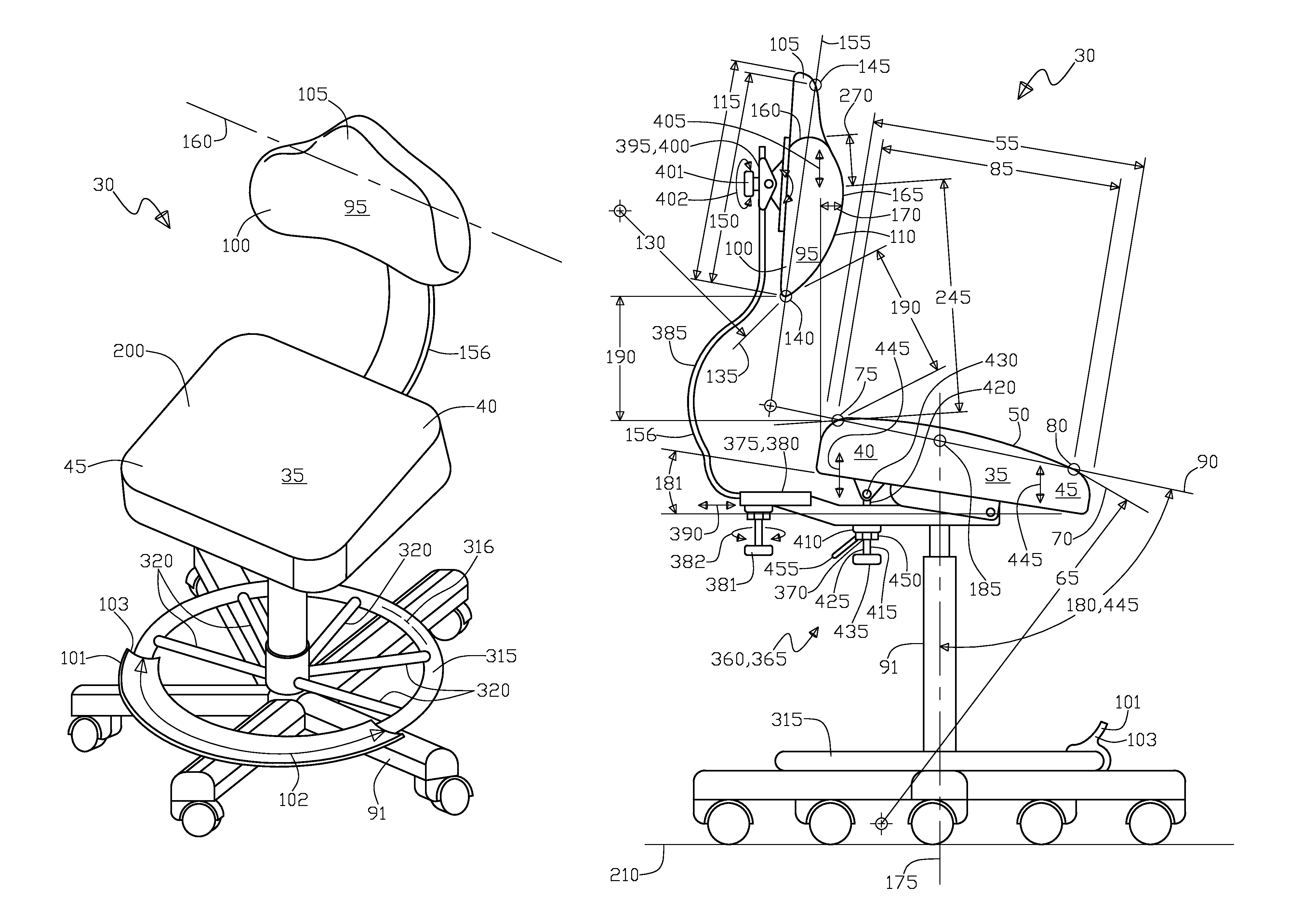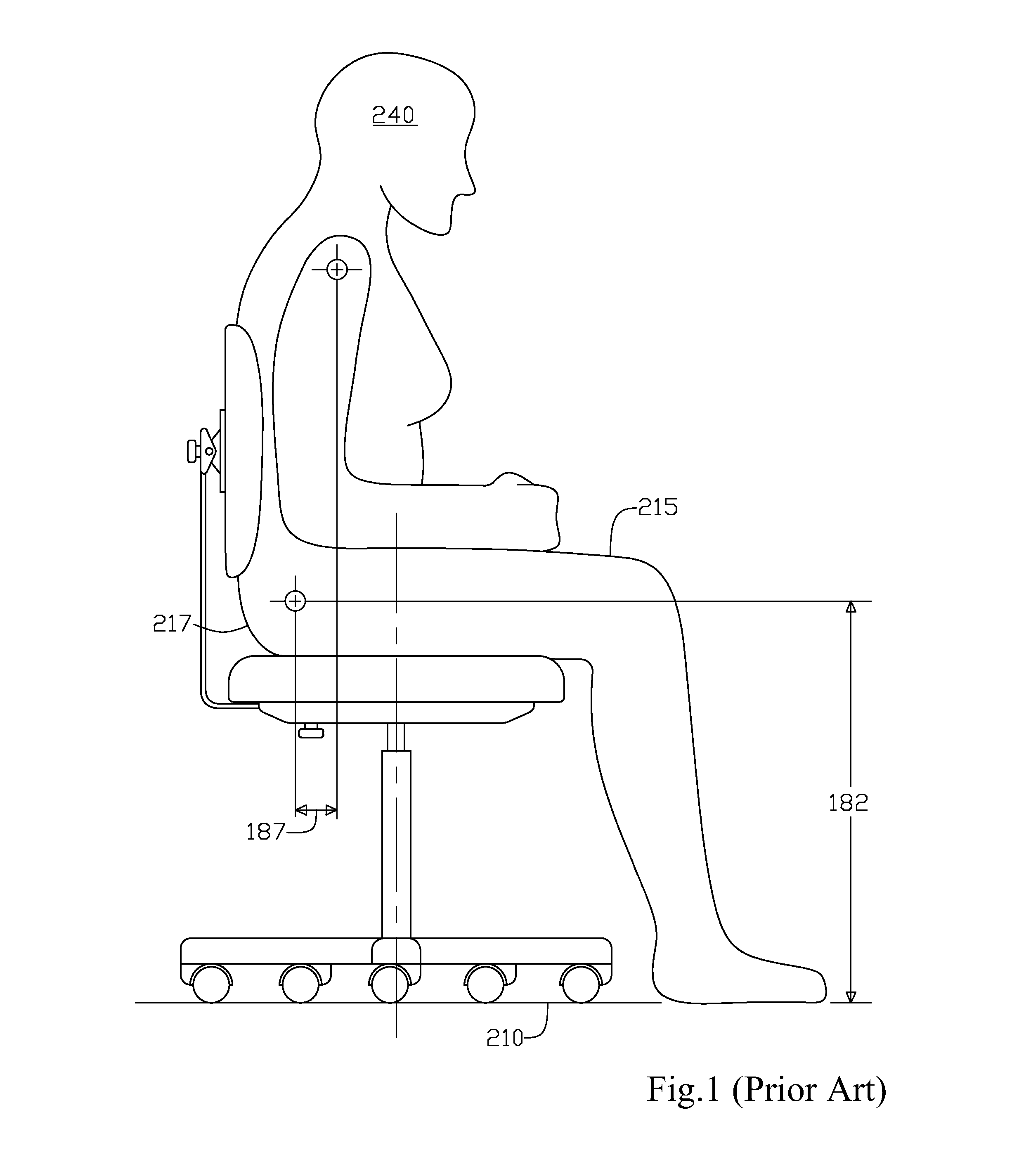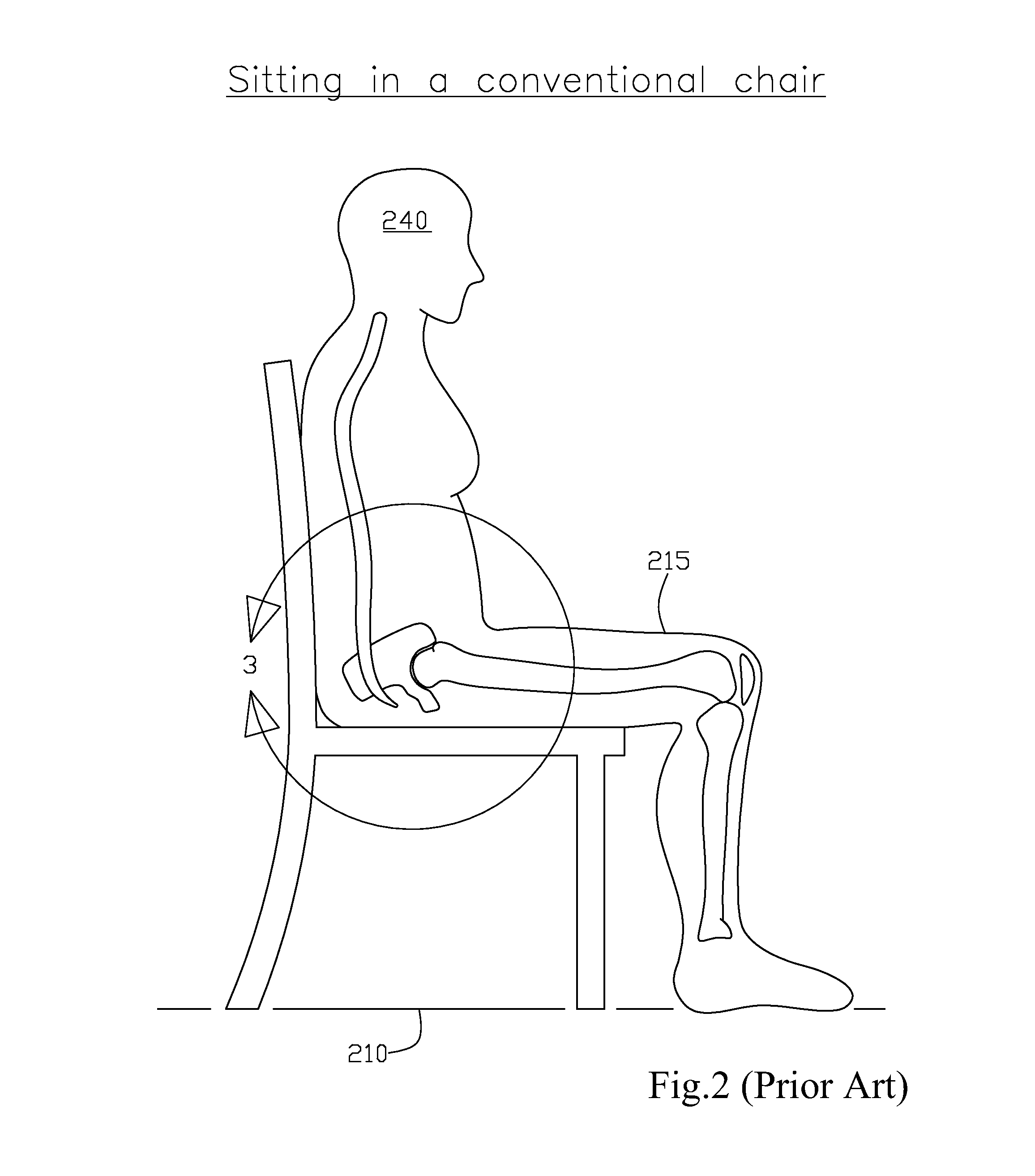In the increasing sedentary environment of the modern workplace, recent trends emerged showing an increase in chronic medical problems, such as musculoskeletal disorders (MSDs) and an increase in worker fatigue arising when workers sit for prolonged durations of time performing tasks that require the worker to sit.
These problems are, in part, due to the growing dependence on computers to perform tasks in offices and increasing levels of
automation in the work place that reduce the amount of manual labor in the workplace.
Over time, chair design has remained largely unchanged, by not providing for the differing needs of
office workers.
The first is an increased load on the health care
system, typically due to an increase in MSDs and similar ailments.
The second significant
impact is a loss of worker productivity through lowered worker efficiency related to loss of concentration and absenteeism in connection with the treatment of MSDs or related ailments.
Additionally,
extended time periods of sitting without beneficial ergonomic support leads to a decrease in efficiency once a worker becomes fatigued.
Fatigue due to
extended time periods of sitting can cause the worker to take more frequent breaks effectively spending less time performing work, a higher incidence of work errors, and decline in worker attitude, all combining to drive up the cost of labor to the employer.
Additionally, with an aging
work force, employers will likely experience additional heath benefit costs as older workers become more prone to MSDs and other ailments.
However, reliance on such proactive steps alone is insufficient.
It is difficult to ensure employees participate in such proactive measures, and it may prove difficult to encourage such behavior.
However, the use of a back pad in conjunction with a means of adjustment presents difficulty in assisting workers in overcoming undesirable ergonomic conditions associated with
extended time periods of sitting.
First, the adjustment mechanism can be complicated to operate.
Moreover, the adjustment mechanism presents a potential failure point in that the adjustment mechanism may break preventing adjustments from being made.
Also, the range of adjustment may allow the worker to adjust the back into a position that may be comfortable temporarily, but after
continuous use lead to fatigue.
Adjustable back designs may also lead to an impediment of the full
range of motion of the seated worker while performing job tasks.
Furthermore, chairs are commonly too big or too small for the worker using them, leading to inappropriate
sitting positions that can cause fatigue also.
While Vik accomplishes providing the worker with
back support, Vik fails to teach a dimensional relationship between the back, hips, and legs of the worker.
Moreover, Vik does not address any problems related to the seat of the chair, nor does Vik provide any assistance in alleviating MSDs or other ailments related to the
soft tissue of the worker's legs and posterior.
Also, because Vik targets a specific region of the back, and the design explicitly requires that the back pad contact the worker at a specific location, workers may either be unfamiliar with where to position the back pad, or find the position uncomfortable and fail to use the pad correctly.
Adat et. al does recognize the need to provide freedom of movement in the worker's upper body; however, the adjustment mechanisms in Adat et. al. are complicated and involves several adjustment points, as well as several mechanisms for adjustme
nt. The various mechanical adjustment structure in Adat et. al. are all prone to unreliability issues after repeate
d use. While Adat et. al. provides a plurality of adjustments to the worker, Adat et. al. also presents difficulty in that the worker must spend time
fine tuning the adjustment at various points to achieve a comfortable backres
This could lead to continual adjustments by the worker, tending to prevent correct positioning.
Moreover, because the worker can be unfamiliar with what backrest position is necessary to correctly align the spine, Yoo presents an opportunity for the worker to adjust the chair backrest into a less desirable or possibly detrimental position.
Without supervision by a person qualified to determine the correct orthopedic position of the chair, Yoo does not solve the need to provide ergonomic support.
Further, in Hatcher et al., there is no method disclosed on how to set the various adjustments of the backrest for specific MSD disorder issues from
prolonged sitting.
The adjustments in Piretti provide greater complexity to the worker using the chair and can allow the worker to adjust the chair backrest members to a less desirable ergonomic position.
Additionally, in Piretti the added adjustment mechanism complexity adds to the overall cost and time required to manufacture and assemble the chair, making the design less feasible for
mass production.
Such an arrangement in Sanchez only complicates the existing problem of adjustment complexity, as to adjust the back portions to the desired position to promote ergonomic support, there are an increasing number of adjustments that need to be made by the worker, thus increasing the time required to make the adjustments and increasing the difficulty in getting the chair
back support positioned to a beneficial or desirable position.
Moreover, Sanchez represents increasing complexity in the manufacturability and
assembly of chairs leading to increased costs of production.
Similarly, in U.S. Pat. No. 6,655,731 B2 to Martin disclosed is an adjustment mechanism that leads to complex adjustments and difficulty in replicating the desired position.
While the arrangement in Martin does provide increasing versatility for a variety of workers, the limited adjustment ability leads to incorrect adjustments, as well as an inability to reproduce or replicate a desirable adjustment setting once the setting has been realized.
Also, Martin lacks specific teaching as to how to set the various adjustments in accordance with the various worker ailments resulting from
prolonged sitting periods.
While the use of a seat of a specific shape or size does not present the aforementioned problems of the adjustable back, the particularity of each shape may not be accommodating to all workers.
While particularly shaped seats may alleviate some MSDs and other ailments related to the
soft tissue of the posterior of the workers, the designs do not provide for any specialized support for the worker's back.
While Steifensand discloses a shorter seat for the female species of the chair, Steifensand fails to provide an adapted chair back for the female.
However, Jeanes, III attempts to solve the problem of discomfort for the infirm or persons confined to a
wheelchair; therefore, Jeanes, III does not disclose a desirable position of the back of a worker that is performing tasks.
Thus, Jeanes, III is not feasible for a worker that is required to perform tasks.
Jeanes, III also fails to provide a specific back to seat relationship desirable to promote correct ergonomics.
In addition the posture Jonsson induces may promote discomfort in the lower portion of the worker's back.
Again, due to the unconventional method of straddling the seat, a worker may not feel comfortable with using the Badia i Farre seat.
Additionally, workers that use the design in Badia i Farre may find it difficult to
mount and dismount the seat.
Further, especially for women, the wearing of a dress as opposed to slacks would preclude the use of this straddling of the seat.
These designs can lead to complexity and difficulty in use, especially when the worker mounts or dismounts the chair.
However, in Serber such an arrangement where ventral support is used, the positioning of the support can lead to interference with the
work task movements performed by the worker, as well as difficulty sitting on the chair and returning to a standing position.
However, this type of
office chair design being introduced decades ago has not meet with much
market acceptance most likely due to the difficulty of the worker mounting and dismounting the chair, the lack of seating position flexibility, and the potential interference of the chair with desks and other office equipment.
Again, in Congleton et. al. when in the dorsal support arrangement, the seat and back do not properly orient the hips of the worker and when in the ventral support arrangement, the issues of sitting and standing from the chair arise, much like in Serber.
The
primary problem Kropa addresses is the ability to rehabilitate lower leg injuries while seating through the use of abductor and adductor type movement attachments that allow the legs to be exercised while seated.
However, in Kropa again, the design presents challenges for using the chair in that worker mounting and dismounting the chair becomes awkward with the addition of the abductor and adductor type movement extensions.
Also, due to the ventral support of the worker in Kropa, the design may limit the number of workers willing or able to use such a design, especially as related to limitations to use of the workers hands and arms.
Again, Kropa does not teach a method of setting adjustments in response to worker fatigue
stemming from extended periods of sitting.
 Login to View More
Login to View More  Login to View More
Login to View More 


